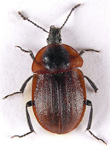Other genera are carrion feeders or predacious at carrion e.g. Thanatophilus and Oiceoptoma. Some Silpha species feed on snails while Dendroxena feed nocturnally on Lepidoptera larvae on trees.
7 genera, 21 species. 9-30mm. Head narrower, and often very much so, than pronotum. Mandibles very robust and often produced forward. Eyes prominent and well developed e.g. Nicrophorus. Antennae 11 segmented with 2nd joint sometimes very small, symetrically clubbed (cf. Lucanidae, Scarabaeidae) or distally thickened. Basal joint elongate but not well developed into a scape (cf. Histeridae).
Pronotum variously sculptured but usually strongly explanate, bordered and narrowed anteriorly. Front margin smoothly rounded e.g. Silpha or emarginate e.g. Aclypea and Thanatophilus.
Elytra truncate in Nicrophilus and Necrodes leaving 3-4 abdominal segments exposed but entire in most British species. Usually with well developed longitudinal ridges, coarsely punctate and variously pubescent (well developed in Aclypea)
Legs robust, tibia with outwardly facing terminal spines (not present in Necrodes), these especially well developed on protibia which may be developed for fossorial habits. Tarsi 5-5-5 with well developed claws.

Nicrophorus
humator

Nicrophorus
vespillo
Nicrophorus
vespilloides

Silpha
atrata
Silpha
atrata
Silpha
atrata

Silpha
laevigata